

Preparing Teachers for a Project-Based World. Authored by Emily Liebtag and Tom Vander Ark.

Is PBL Right for All Students? - New Tech Network New Tech Network. While there is no such thing as a dumb question, there are questions that reveal our misunderstandings.
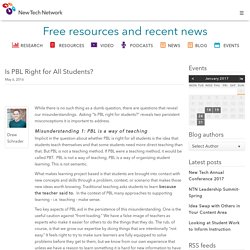
Asking “Is PBL right for students?” Reveals two persistent misconceptions it is important to address. Misunderstanding 1: PBL is a way of teaching Implicit in the question about whether PBL is right for all students is the idea that students teach themselves and that some students need more direct teaching than that. What the Heck is Inquiry-Based Learning? Inquiry-based learning is more than asking a student what he or she wants to know.
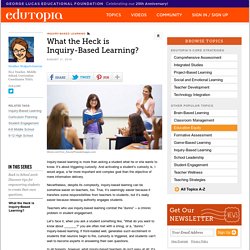
It’s about triggering curiosity. And activating a student’s curiosity is, I would argue, a far more important and complex goal than the objective of mere information delivery. Nevertheless, despite its complexity, inquiry-based learning can be somehow easier on teachers, too. True, it’s seemingly easier because it transfers some responsibilities from teachers to students, but it’s really easier because releasing authority engages students. 14 Tech Tools to Enhance Project-Based Learning. Bob Lenz (@pblbob) and Sally Kingston (@SallyKingston5) shared 17 Teacher Tech Tools for High-Quality Project-Based Learning.
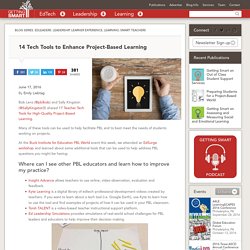
Many of these tools can be used to help facilitate PBL and to best meet the needs of students working on projects. At the Buck Institute for Education PBL World event this week, we attended an EdSurge workshop and learned about some additional tools that can be used to help address PBL questions you might be having: Why Project Based Learning Hasn’t Gone Mainstream (And What We Can Do About It)
Project-Based Learning (PBL) is one of the hottest buzzwords in education, and it’s easy to see why.

PBL combines standards-based curriculum with empowering students to solve real world challenges. Through projects, students master skills—critical thinking, creativity, communication, and collaboration—that are hard to teach in traditional classrooms. Some project-based schools even report 20% higher standardized test scores than those with conventional classrooms. As a co-founder of CrowdSchool, a PBL platform, I’ve spent nearly two years talking with teachers, schools, and districts about how to make it easier to teach with PBL. Design Thinking and PBL. While project-based learning has existed for decades, design thinking has recently entered the education lexicon, even though its history can be traced back to Herbert A.
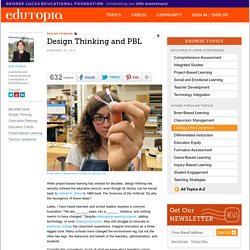
Simon's 1969 book The Sciences of the Artificial. So why the resurgence of these ideas? Lately, I have heard teachers and school leaders express a common frustration: "We are _______ years into a _______ initiative, and nothing seems to have changed. " Despite redesigning learning spaces, adding technology, or even flipping instruction, they still struggle to innovate or positively change the classroom experience. Imagine innovation as a three-legged stool. What's Next? Personalized, Project-Based Learning. It’s easy to do project-based learning, it’s just hard to do it well.
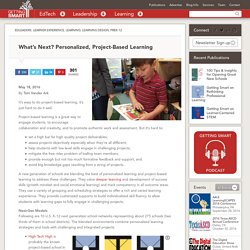
Project-based learning is a great way to engage students, to encourage collaboration and creativity, and to promote authentic work and assessment. But it’s hard to: set a high bar for high quality project deliverables;assess projects objectively especially when they’re all different;help students with low level skills engage in challenging projects;mitigate the free rider problem of loafing team members;provide enough but not too much formative feedback and support; andavoid big knowledge gaps resulting from a string of projects.
5 Tips For Integrating Project-Based Learning In Any Content Area - 5 Tips For Integrating Project-Based Learning In Any Content Area by Shann Griffith Ed note: Though this post written with elementary aged students in mind, it applies to all content areas in concept, thus the more general title and the in-text mention of elementary school.

The elementary years are critical for grounding a student’s understanding of key concepts, across subject areas, to tangible processes and results. To help students grasp the intersections between what they learn in school to the world around them, project-based learning is a handy tool. Using Project Based Learning To Turn Students into Responsible Data Consumers. At South Miami Middle Community School, our mission is to improve upon students’ abilities to read, write, comprehend, and articulate through an integrated curriculum, which will prepare all students for the diversely multicultural and technological world of the twenty-first century.
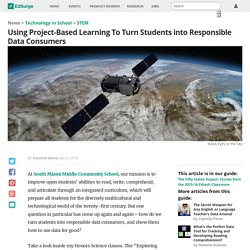
But one question in particular has come up again and again—how do we turn students into responsible data consumers, and show them how to use data for good? Take a look inside my Honors Science classes. Architecture, Psychology... and Furniture? Project-based learning, maker lessons, and hands-on learning are all the rage in elementary and middle school, but can high school teachers do these projects within the confines of curriculum coverage, time limits, and disciplinary silos?
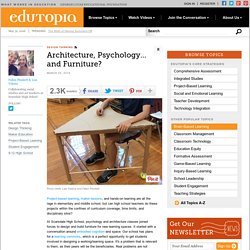
At Scarsdale High School, psychology and architecture classes joined forces to design and build furniture for new learning spaces. It started with a conversation around embodied cognition and space. Project Based Teaching Rubric. When Is PBL Rigorous? By John R. Walkup, Ph.D. No doubt about it, Project-Based Learning (PBL) is big and getting bigger, especially in science. Well-designed PBL provides students opportunities to develop critical thinking skills while they work on engaging projects that tie the relevance of the curriculum to their personal needs.
How Project-Based Learning Fosters Community Change. Solving real world issues that matter is important to us as adults–and it’s important to our students. When we bring real world issues to the classroom and allow students to lead, we can foster community change. One school in South Carolina is doing this by tackling a daunting and important subject: human trafficking. Westwood High School is in its third year working on a project called Globalize 13. Globalize 13 is a service-learning project for secondary schools that presents lessons about slavery within the context of the 13th Amendment, the amendment that abolished slavery 150 years ago. 6 Strategies for Differentiated Instruction in Project-Based Learning. Project-based learning (PBL) naturally lends itself to differentiated instruction. By design, it is student-centered, student-driven, and gives space for teachers to meet the needs of students in a variety of ways.
PBL can allow for effective differentiation in assessment as well as daily management and instruction. PBL experts will tell you this, but I often hear teachers ask for real examples, specifics to help them contextualize what it "looks like" in the classroom. We all need to try out specific ideas and strategies to get our brains working in a different context. Preparing Students for a Project-Based World "Everybody's life feels like a series of projects," said Chris Gagnon, who oversees McKinsey's organizational health research. On a podcast about organizations Going From Fragile to Agile Chris talked about project-based organizations. He said projects are how leading organizations develop new products, bring things to market, approach customers in different ways, and reduce costs. There are no longer easy-to-follow models for organizational design; the world is changing too fast.
Preparing Students for a Project-Based World How to Make Sure That Project-based Learning is Applied Well in Schools. By Thom Markham Now that project-based learning (PBL) is becoming more popular, the doubters and haters also have surfaced. The recent anti-PBL message by David Brooks in the New York Times, which was fortunately well rebutted, exemplifies the resistance. Citing High Tech High in San Diego, Brooks’ core message is that PBL is a kind of mindless education dressed up by technology and devoid of the ‘wisdom’ taught in traditional schools.
Given that there are probably another thousand-plus schools across the country embracing PBL, this is a serious charge. And it’s false. But it should also be a warning to PBL advocates. This is no one’s fault. 8 Needs For Project-Based Learning In The 21st Century. Resources for Assessment in Project-Based Learning. Learning by Doing: A Teacher Transitions Into PBL. 5 Tips To Create Engaging Video Based Learning. As per Cisco Systems, 84% of internet traffic will be video content by 2018. So, what does this mean for the Instructional Designers or training professionals? How can you create effective video based learning to engage your audiences? We have all heard of the catchphrase more than often; visuals speak 1000 words, so videos speak a million or a trillion of words.
As learning experts have also rightly pointed out, it’s better to show than to tell the learners. It has been proven by most of the researchers that visually demonstrating a new skill or behavior can be an important component of multi-modal instruction. As humans, we all like or even love videos. Though this type of learning is not new, with the advancement of YouTube it has become increasingly popular. Make Literacy a Focus of PBL. What's the role of literacy in project-based learning? It's hard to imagine a project, in any subject area, that doesn't involve the essential skills of speaking, listening, reading, and writing. That was the overwhelming message from participants in a recent Twitter chat about PBL and literacy (#IRAchat, hosted by the International Reading Association). "Asking questions, reading with a question in mind, summarizing-not sure you could do PBL without including literacy skills," said instructional coach Sue Brusco (@bruscos).
PBL Resources. PBL and Global Inquiry. Resources for Assessment in Project-Based Learning. Everything Teachers Need to Know about Project Based Learning- 6 Must Read Books.
Exercise Science in Action with Project Based Learning. Maximizing Profit: The PBL Classroom Without PBL. Use PBL to Inspire Passion and Teach Lifelong Learning. Over the past decade, the No Child Left Behind Act and Common Core have created a new era of student and teacher accountability. Teachers have been asked to improve student achievement and test scores across all demographic groups and income levels. According to Striving for Student Success: A Model of Shared Accountability (PDF), "[i]n the current school reform atmosphere, in which individual schools and teachers are being judged by their own students' outcomes, this notion of 'shared accountability' is rare.
" Project Based Learning Connects To Flip Learning… Plus Hundreds of Resources. How Maker Culture Builds Stronger Learning Communities. Is PBL Rigorous? 12 Timeless Project-Based Learning Resources. The Difference Between Doing Projects Versus Learning Through Projects. 10 ways to Ensure Significant Content is part of Project Based Learning … PBL Essential Elements Series. What Project-Based Learning Is — and What It Isn’t. Transform Your Classroom into a Makerspace. This is the difference between 'projects' and 'project-based learning'
Project Based Assignments and Providing Meaningful Feedback Through WeLearnedIt. Makerspaces. + Project Based Learning. Four Essential Principles of Blended Learning.